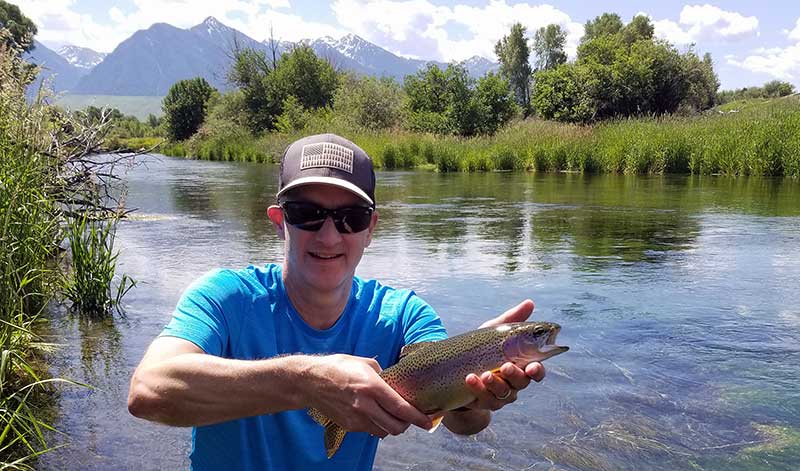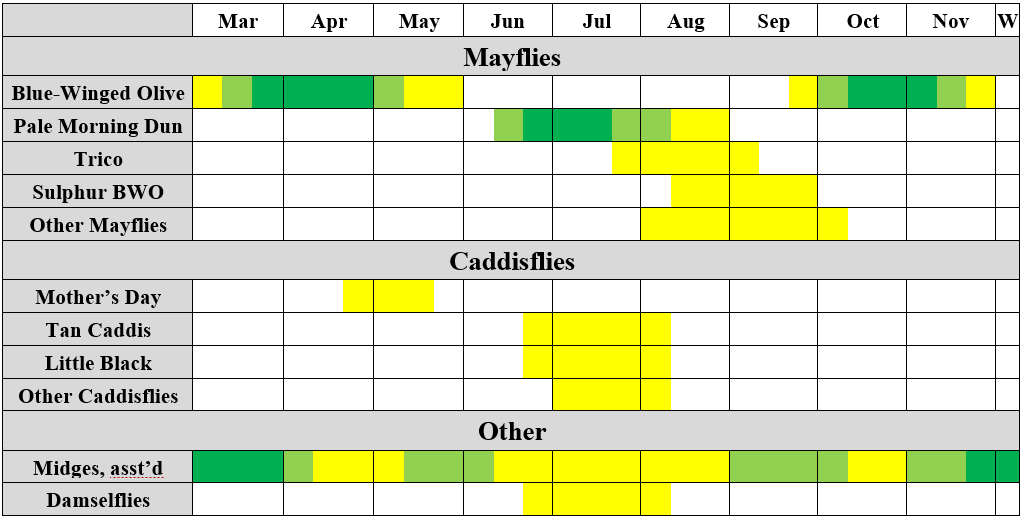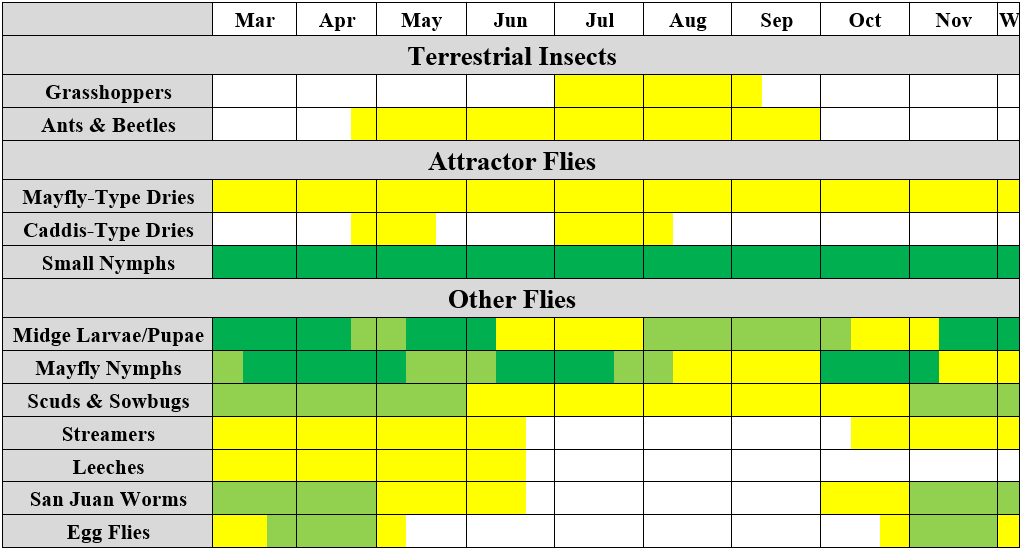Private, famous, difficult to access during the prime summer season, and full of wary trout, the Paradise Valley spring creeks are for anglers who want to fish like herons
The Paradise Valley spring creeks (Nelson’s, Armstrong’s, and Depuy) are private spring creeks several miles south of Livingston. They drain into the Yellowstone. Other spring creeks are found in the Gallatin and Madison valleys, but those feeding the Yellowstone are the most famous.
The creeks charge rod fees of $40-140 per day depending on the season, with the lowest rates in the winter and the highest during the summer PMD hatches in July. At certain times of year these creeks offer the most consistent fishing in the area, and the guarantee of limited angling competition coupled with easy access, since only 6-16 anglers are permitted on the creeks each day. Advance reservations are absolutely required. I am writing this sentence in mid-January 2024. Many prime dates in July 2025 are already booked solid.
Unlike most streams in the area, these are flat, heavily-modified, private creeks with many amenities such as easy access roads, benches, warming huts, and other comforts more common on English chalk streams than trout streams in the American West.

What the creeks do not offer is easy fishing. These are not like some similar manicured streams elsewhere in the United States, with big, dumb fish whose populations are kept artifically high via stocking. The trout that live in the creeks are all wild, often large, and very experienced. Except in the dead of winter, they see many flies each day, and laugh at all but the best presentations.
Except during the early spring rainbow run and BWO hatches and perhaps during the early part of the PMD emergence in late June and early July, the creeks are consistently challenging, with spooky, hard-to-fool trout that are more likely to eat tiny crippled or emerging insects than any fly that’s easier to fish and see. Fine tippets, long leaders, and perfect casts are required. On one guided trip a few years back, my client caught seven fish over a ten-hour day of fishing. Not great, but of the other half-dozen anglers on the creek, not one caught a fish.
Suffice it to say that the spring creeks are experts-only water, and are not for number-hunters. Instead, these are good places to visit if you want a challenge, and to spot and stalk almost every fish you target.

We primarily guide on the creeks in March and April, when reservations are easier to get and the creeks are probably the most consistent if not always the best fisheries within a few minutes of Livingston.
- Location: The Paradise Valley Spring Creeks are located a few minutes south of Livingston at the north end of Paradise Valley. Armstrong and Depuy spring creeks enter the west side of the Yellowstone River. Nelson’s enters the east.
- Access: All creeks are accessed by gravel roads crossing working cattle ranches. Normal passenger cars can handle these roads. All creeks have numerous manicured angling trails, warming huts, benches to sit and watch the water, picnic tables, etc. The wading in most cases is easy.
- Season: The creeks are open and get fished 365 days a year. The best fishing tends to occur in March and April, late June and early July, and perhaps from mid-October until around Thanksgiving.
- Our Favorite Creek: Because it has the widest range of water types including a pond and good nymph-fishing water, and is also simply the longest of the creeks at over two miles, Depuy is our favorite spring creek.
- What They Do Best: While the early summer PMD hatches offer the most consistent fishing on the creeks and are renowned worldwide, the difficulty in getting reservations at this time means that we actually prefer the March and April midge, BWO, and egg pattern fishing. At this time experienced anglers can catch good numbers of solid trout using a wide range of techniques, without the expense and often without the relative crowds of early July.
- Perfect Clients: Patient expert anglers who want a slow-paced day of matching wits with a relatively small number of challenging fish rather than a fast-paced day on easier and sometimes even larger fish.
- Worst Clients: Out of all the different waters we fish, the spring creeks are by far the worst choices for beginners, novices, and kids.
Description and Access
Unlike most of our streams, the Paradise Valley spring creeks are flat, with abundant in-stream vegetation. All have some riffles and a handful of runs, usually below road culverts, but long, flat pools and slicks predominate. Depuy has the greatest variety of water, while Nelson’s is quite flat, for the most part. All three streams are crystal clear, with bottoms composed primarily of gravel, though some silt accumulates around the numerous clumps of aquatic vegetation, so it’s important to watch where you step. One notable exception to this pattern is the large pond on Depuy, which offers some stillwater fishing options, including belly-boating.
Nelson Spring Creek is on the east bank of the Yellowstone, Armstrong on the west bank. Depuy is primarily composed of Armstrong’s water that has been diverted into an old river channel, making it, according to state law at least, a manmade waterway, though you wouldn’t know that if I didn’t just tell you.
All three creeks are extremely easy to access, with numerous small access roads and wide angler tracks lining the banks. Wading is easy, with firm gravel bottoms. Some sections are almost handicapped-accessible. Due to their flat character, ease of access, amenities that make it easy to take a break, and guaranteed limited competition, these are very popular fisheries for older and less-fit anglers who have enough money to afford the access fees.
The Angling
The Fish
- Rainbow: Rainbows predominate in all creeks. They average 12 to 18 inches.
- Brown: Browns are present in all creeks year-round, but are most common in fall and early winter, when spawners from the Yellowstone enter. Residents average 12-20 inches. Spawners average 16-22 inches.
- Yellowstone Cutthroat: Cutts are present but uncommon in all creeks year-round. Numbers increase in late spring, both as a result of muddy water in the Yellowstone and due to limited spawning runs, but they are never common. They average 13-18 inches.
- Whitefish: Whitefish are possible year-round but uncommon in all creeks.
Fishing Tactics
None of the creeks are suitable for beginner anglers, and even intermediates will often struggle. At times, even experts get skunked on the creeks. These creeks are flat, clear, enjoy catch and release regulations that let a fish be fooled a few times and still grow large, and have abundant populations of a relatively small number of insects, all of which breeds fish that typically focus on particular stages of specific insects and demand perfect dead drifts. Cautious approaches, long and fine leaders, and a lot of luck are all helpful.
For tackle, think a nine-foot three, four, or five-weight rod for most fishing. For streamer fishing in spring and fall, you might get away with a six-weight. Save for those used with streamers, leaders should begin at nine feet. Fifteen-footers may be required. Again with the exception of streamers, tippets should be light, 5X fluorocarbon at the heaviest. 6X and 7X may also be needed. The spring creeks are the only places in Montana where 7X is ever required. Avoid wearing bright or flashy clothing, wade like a heron rather than a buffalo (and only wade when you must), and use streamside vegetation to mask your approach.
The creeks are open and can fish well all year. In the winter, midge larvae and pupae are the top bets, with some possibility of dry midge fishing or a larger trout that will chase a streamer. Rainbows begin moving into the creeks to spawn in February, and streamers, eggs, and San Juan Worms begin working well at this time. BWO start in March, and some caddis appear in April and early May. Late May and early June see few hatches other than the occasional midge, so small nymphs or streamers are the best bets. The top hatch of the year is the late June-late July/early August PMDs, and the creeks are often fully booked a year in advance during this period. Small terrestrials and attractor dries as well as evening caddis are also good choices at this time. Tricos and the cream summer Baetis or (Western Sulfurs) appear in August and September, while fall Baetis appear from late or early October through December. Browns begin moving in to spawn in October, making streamers and eggs a good bet again through Thanksgiving or even into December.
Note on Spawning Trout
March through April is rainbow trout spawning season on the creeks. This period can bring phenomenal fishing, but we want to make clear that we absolutely do not advocate targeting actively-spawning trout. These are very easy to identify and avoid on the spring creeks. From mid-March through April, avoid areas of shallow, clean gravel with obvious trout present. Since all trout on the creeks are wild, and because spawning on the creeks also supports fish populations in the Yellowstone River, it is completely unethical to target trout that are “doing the deed.”
Instead, target pre-spawn and post-spawn trout in the deeper areas. Often large numbers of fish gather in the deeper pools below spawning areas to eat eggs as well as aquatic insects disturbed by spawning activity. There are always plenty of fish in these pools, and you won’t need to drink yourself into a stupor to sleep due to guilt after targeting these fish.
(Note that Depuy at least blocks off the most important spawning areas with orange no-fishing flags seasonally to prevent anglers from temptation, but the trout do spawn outside these areas.)
Flies and Hatches
Note that patterns of all classes should be more “tech” than we’ve suggested elsewhere on this site. Cripples, emergers, drowned duns, and the like are all far more likely to be effective than high-floating dries. By the same token, nymphs should be tied slender and sparse. Oddball flies that fall into these categories and match the predominant midges, PMD, and BWO are definitely worth trying, as the fish get very suspicious of the same-old, same-old.


Top Flies
- PMD Sparkle Dun, #16-22
- BWO Sparkle Dun, #18-24
- Rusty Spinner, #18-22
- Epoxyback BWO Nymph, #18-20
- Epoxyback PMD Nymph, #16-20
- WD-40, #16-22
- Zebra Midge, #18-22
- Flexi San Juan Worm, #16
- Olive Woolly Bugger, #8
- Light Pink Egg Pattern, #16
Links
- Armstrong Spring Creek
- Depuy Spring Creek
- Nelson’s Spring Creek
- Spring Creek Specialists: This shed-size fly shop is located on Depuy Spring Creek and is dedicated exclusively to flies and tackle for fishing the spring creeks. It’s the one shop I always visit when I’m guiding on one of the creeks.